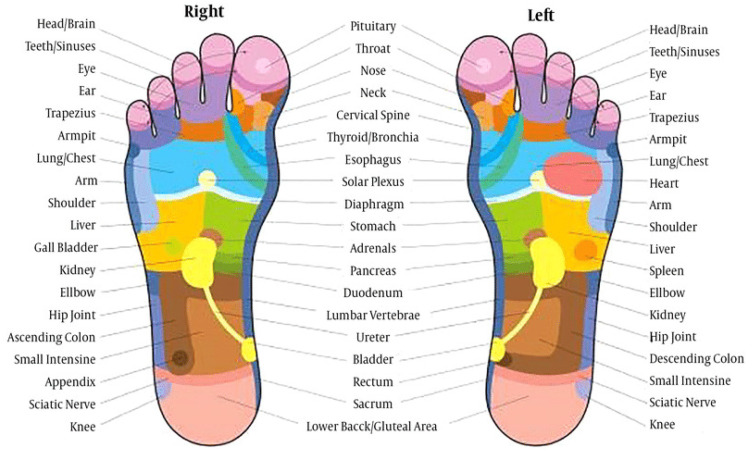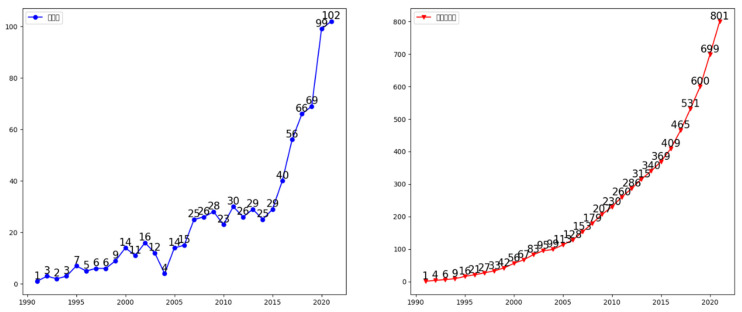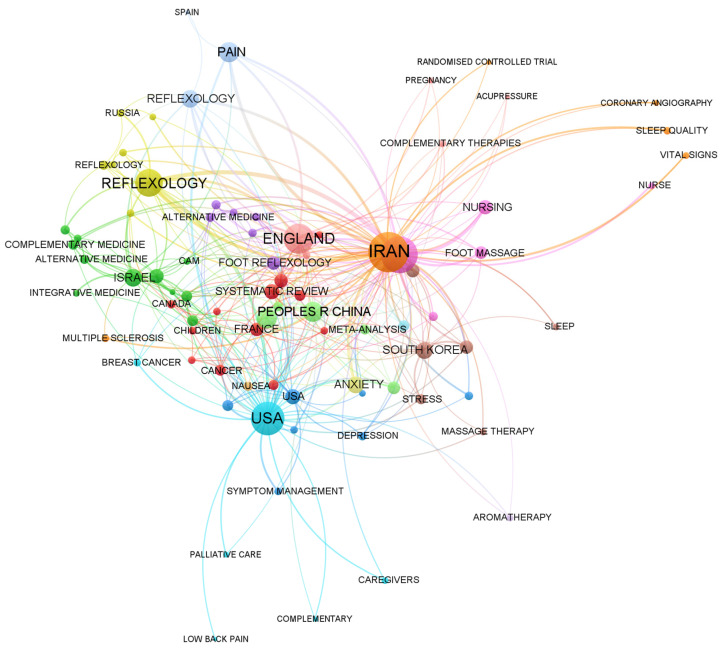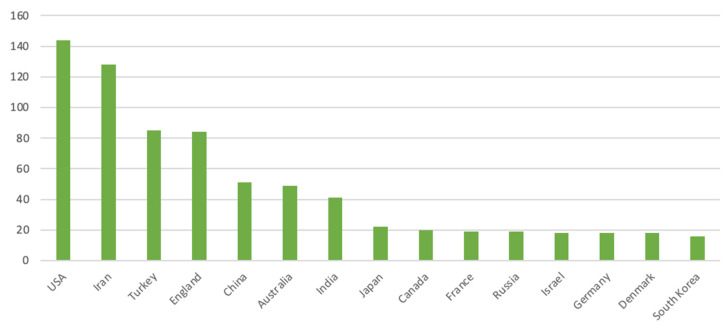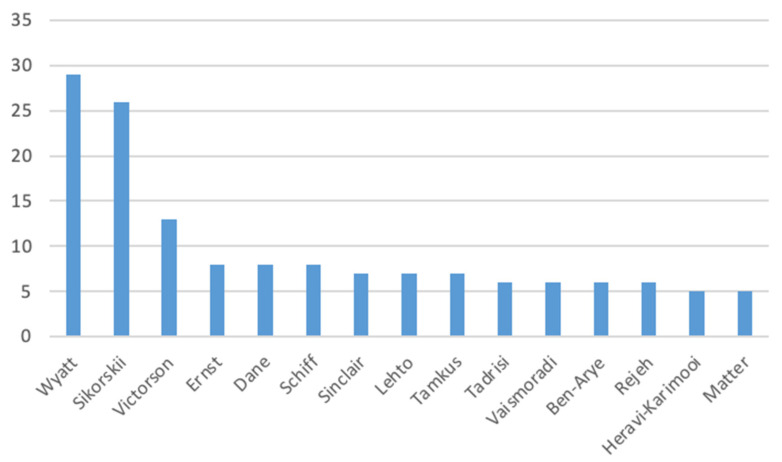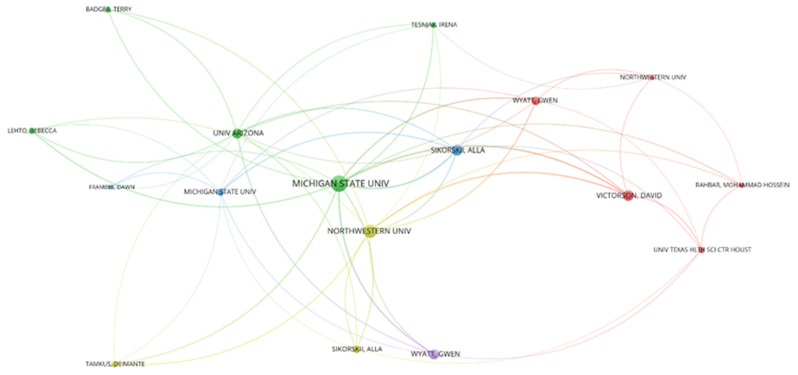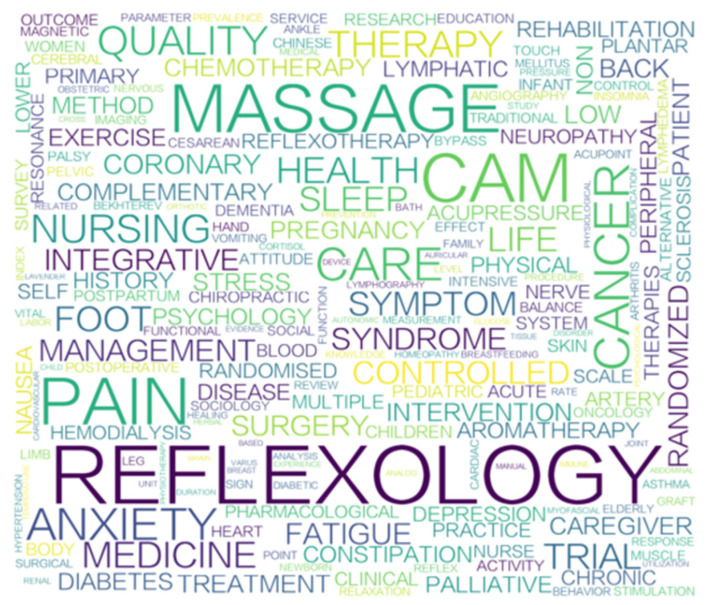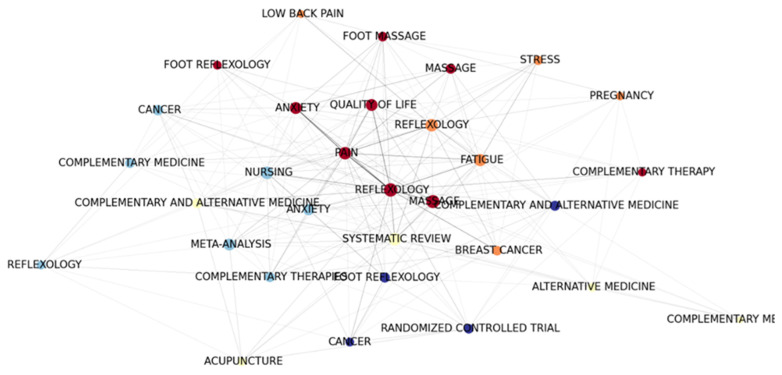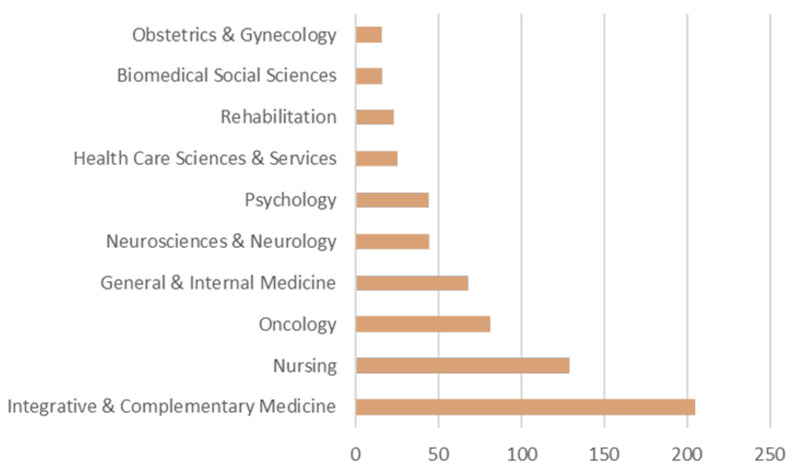Abstract
Foot reflexology is a non-invasive complementary therapy that is increasingly being accepted by modern people in recent years. To understand the research trends and prospects of foot reflexology in the past 31 years, this study used the Web of Science core collection as the data source and two visualization tools, COOC and VOSviewer, to analyze the literature related to the field of foot reflexology from 1991 to 2021. This study found that the number of articles published in the field of foot reflexology has been increasing year by year, and the top three journals with the most articles are Complementary Therapies in Clinical Practice, Therapies in Medicine, and the Journal of Alternative and Complementary Medicine. The top three most prolific authors are Wyatt, Sikorskii, and Victorson, and the core institutions in the field of foot reflexology are Michigan State University, Northwestern University, Tehran University of Medical Sciences, and the University of Exeter. Foot reflexology has been shown to have a moderating effect on anxiety, fatigue, and cancer, and is a topic of ongoing and future research. This study uses this bibliometric analysis of foot reflexology literature to provide an overview of prior knowledge and a reference direction for modern preventive medicine.
Keywords: foot reflexology, bibliometric analysis, preventive medicine, corporate online open course, VOSviewer
1. Introduction
Reflexology is an ancient therapy that was used by the early Chinese, Egyptians, and North American indigenous tribes for healing, but it was not until the 19th century that the medical community, nursing, and complementary and alternative medicine (CAM) practitioners began to explore it scientifically. In reflexology, there are five zones on each side of the body, each of which spreads down the arm and is confined to a single finger, while also extending down the body and leg until it aligns with a corresponding toe on the foot [1]. Reflexology is also known as regional therapy and reflex massage therapy. Its principle is that each area of the hands and feet represents each part of the body, such as the heart, liver, spleen, lungs, kidneys, and other internal organs, and when various areas of the hands and feet are massaged, it can stimulate energy, blood, nutrition, or nerves, resulting in therapeutic effects, including relieving mental stress, detoxifying the body, promoting blood circulation, losing weight, delaying aging, and improving internal health [2], as shown in Figure 1.
Figure 1.
Foot reflexology chart.
On the physical, emotional, and spiritual levels, reflexology often improves individuals’ physical health and well-being. Briefly, people choose reflexology because:
It does not use any drugs or chemicals and is the best choice for many health problems;
It can reduce pain;
It helps maintain physical flexibility and athleticism;
It relaxes the limbs, especially the hands and feet, and the whole body;
It stimulates the body to release pain-relieving chemicals;
It can be used as a means of preventing disease;
It promotes recovery from physical injury, especially for the hands and feet [3,4];
It triggers the release of endorphins and enkephalins, which help relieve pain and improve mental energy and well-being [5].
CAM can be divided into four types of treatment: (1) traditional Asian medical systems (TAMS), including traditional Chinese medicine, acupuncture, and acupressure; (2) alternative medicinal systems (AMS), including homeopathy and herbal therapy; (3) manual body-based therapies (MBBTs), including massage therapy, chiropractic therapy, osteopathy, and reflexology; and (4) mind-body therapies (MBTs), including hypnotherapy and psychotherapy [6,7]. Reflexology is one of the most commonly used modalities of CAM in Europe [8]. The most common reason for using CAM is dissatisfaction with the outcome of traditional medical care (CAM is most commonly used for musculoskeletal problems). A survey of reflexology use in the United Kingdom found an average one-year prevalence of 41.1% and an average lifetime use of 51.8% [9]. Usage rates for older adults in the United States range from 23% to 62.9% [10]. In Taiwan, the one-year usage rate is 85.65% [11]. In many countries, CAM is associated with the cosmetic industry and unorthodox medicine, and CAM is actively used in hospices, nursing homes, and obstetrics in healthcare settings. A study of clinicians showed that, on average, physicians consider CAM to be moderately effective, and 23.3% of them consider it to be an effective method of treatment [12] and would recommend it to their patients. The most common reasons for recommendation are to relax musculoskeletal pain, chronic disease, and nerve pain [13,14,15]. There is a worldwide shift in the attitude towards CAM due to its use as secondary care and integration into mainstream medical care [16]. In general, complementary and alternative medicine is increasingly recognized as a safe and effective way to reduce pain and illness [16]. It is also a non-invasive and inexpensive form of health care that can be used by most people (including children, the elderly, cancer patients, and pregnant women) [17]. Foot reflexology is one of the methods used by complementary and alternative medicine in medical treatment [1,18], and it differs from general foot massage as it targets the reflex zones of the feet corresponding to the body part in a deeper manner. Foot reflexology has been trained and certified by professional foot reflexologists as researchers [19,20], and it is commonly used in medical institutions as adjunctive therapy in an attempt to relieve pain or improve sleep when nurses are caring for patients.
Two internationally recognized reflexology methods are the Ingham method and the Rwo Shur method. The Ingham method is performed without using any tools, while the Rwo Shur method uses tools such as wooden sticks [4]. It is considered to be the most commonly used CAM for older people [21]. However, studies have also shown that younger people are more likely to use CAM than older people [22]. The founder of the Rwo Shur method (also known as Father Josef’s method), Father Josef Eugster Johann, suffered from osteoarthritis. After reading Gesund in die Zukunft (The Future of Health) by Schwester Hedi Masafret, he invented a new therapeutic method of foot reflexology to treat his osteoarthritis and suggested that “this home remedy could save medical expenses.” He founded the Fr. Josef Eugster Holistic Human Development (H.D.) Association and trained many foot reflexologists who have since helped scores of patients with stroke, insomnia, stomach pain, and neurological and skeletal disorders. Furthermore, the H.D. Association continues to explore reflexology clues in various parts of the body and develop new techniques that are useful in restoring health [23]. The World Health Organization (WHO) stated in 1990 that the combination of traditional drug-free podiatric medicine with modern surgical medicine can improve individuals’ understanding of their health while increasing medical coverage [24]. Thus, it is clear that foot reflexology is gradually being used as a non-invasive complementary therapy in medicine, nursing, and CAM practitioners to promote health restoration and the revitalization of various body parts at all ages as it has been proposed to enhance blood flow, relax the body, and improve injury healing [25].
Most clinical studies have found foot reflexology to be effective in reducing pain, including headache pain, back pain, joint pain [26], cesarean pain [27], acute pain in infants [28,29], pregnancy pain [30], labor pain [31,32,33,34,35,36], leg edema in pregnancy [37], postpartum women’s fatigue [38], pain from surgical medical examinations [39,40], organ removal or transplant pain [41,42,43,44], and various cancer pains [45,46,47,48,49]. It can also be used as a treatment for individual musculoskeletal cases [50]. In addition, foot reflexology is also an effective treatment for strokes, insomnia, asthma, diabetes, premenstrual syndrome, dementia, cancers, multiple sclerosis, and idiopathic detrusor overactivity [51,52,53]. It has also been studied for use in hospice units to alleviate discomfort and pain in patients at the end of life [54]. In fact, there are many studies exploring reflexology on the quality of life with cancer.
This study used bibliometric methods to uncover the development patterns in the field of foot reflexology research and to provide new academic perspectives and insights. To the best of our knowledge, no peer review published literature has summarized and analyzed the development of foot reflexology thus far. This study provides a comprehensive review of the research progress in the field of foot reflexology from its infancy to its peak between 1991 and 2021 (there has been research conducted prior to 1991 but it had poor methodology and publications) and offers insights into the prospects and opportunities for research in the field of foot reflexology. At the same time, the research results could facilitate the design and development of foot reflexology assistive tools and bring about a healthier and safer life for humans, giving greater value and energy to life.
2. Materials and Methods
2.1. Data Sources
In this study, the Web of Science (WOS) core collection was used to search the relevant literature in the field of foot reflexology. The search period covered a total of 31 years, from 1991 to 2021, and the process included an advanced search using TS = (“Foot massage” or “foot massage” or “reflexology”) as keywords to search all academic publications on topics related to foot reflexology. A total of 806 papers were retrieved, and 801 valid papers were obtained by importing the above keywords into COOC [55].
2.2. Analytical Methods
This study used the bibliometric software COOC version 12.6, which includes the abilities of data extraction, data cleaning, descriptive statistics, relationship construction, cluster mapping, theme evolution, and research frontiers, to analyze the data, and then imported the data into the VOSviewer visualization software (developed by Nees Jan van Eck and Ludo Waltman, researchers at Leiden University’s Center for Science and Technology Research; Leiden; Netherlands) for subsequent analysis [50]. The data were analyzed from the perspectives of the annual number of publications, journals, prolific authors, research institutions, authors and collaboration networks of research institutions, keywords, highly cited papers, and research fields, in order to provide an important reference for subsequent research and practitioners of foot reflexology [56].
3. Results
From 1991 to 2021, the Web of Science Core Collection collected 806 papers related to foot reflexology, of which there were 5 duplicates. The types of literature included 612 research papers, 107 review papers, and 82 papers of other types [55]. There were 414 publications in the field of foot reflexology, of which 94% were in English and 6% were in another language, including 1063 institutions in 62 countries, covering 75 research directions and 102 research areas [57].
The following subsections address the bibliometric profile of the literature on foot reflexology in terms of the annual number of publications, journals, prolific authors, research institutions, authors and collaboration networks of research institutions, keywords, and highly cited papers.
3.1. Annual Number of Publications
The evolution of the steady growth of foot reflexology-related research publications between 1991 and 2021 revealed that foot reflexology research results are increasing due to the advantages of foot reflexology as a complementary medicine and the findings and applications from relevant research (as shown in Figure 2) as well as journals accepting CAM reflexology articles for publication and an increasing number of researchers interested in CAM and reflexology.
Figure 2.
Distribution and cumulative volume of foot reflexology papers published over the years.
The development of foot reflexology can be roughly divided into three stages, namely, the initial nascent stage, the primary growth stage, and the rapid development stage. The initial nascent stage (1991–2006) lasted for 16 years, with a total of 128 publications and an average of 8 publications per year. During the primary growth stage (2007–2015), scientific researchers began to show great interest in foot reflexology research, and the total number of publications grew to 241 publications, with an average of 27 publications per year. During the rapid development stage (2016–2021), the number of annual publications accelerated, with a total of 434 publications accumulated over six years and an average of 72 publications per year, representing nine times the amount of research performed during the primary growth stage. This study of CAM and foot reflexology found that the significant papers in the field were mainly concentrated in the initial nascent stage (eight papers in total, accounting for 53% of the number of significant papers), and the remaining seven papers (47%) were concentrated in the primary growth stage. The results of previous studies, therefore, laid the foundation for future studies. The rapid turnover of research papers published in the third stage, with the number of papers exceeding 102 for the first time in 2021, showed a trend of diversified growth in the field of foot reflexology and its richer research content, indicating the extensive and prominent importance of this field in the world scientific community and reflexology practitioners.
3.2. Journals
In this study, by counting the number of foot reflexology papers in the Web of Science Core Collection against foot reflexology source publications, it was found that 801 papers were published in 414 journals during the past 31 years. The top 10 countries in terms of the number of papers issued were the United States (33.3%), the United Kingdom (23.9%), the Netherlands (4.1%), Switzerland (3.9%), Germany (3.6%), Iran (3.6%), Turkey (3.6%), Canada (3.1%), Australia (2.9%), and India (2.9%). Taiwan (0.5%) ranked 14th among the 28 countries in which the papers were published. Among the top 15 journals with the most published articles, Complementary Therapies in Clinical Practice accounted for 11.1%, Complementary Therapies in Medicine accounted for 9.6%, the Journal of Alternative and Complementary Medicine accounted for 6.30%, Evidence-based Complementary and Alternative Medicine accounted for 3.90%, and the Cochrane Database of Systematic Reviews accounted for 3.10%, which together accounted for one-third of the total number of published articles. The Journal Citation Indicator (JCI) values for these journals fell between 0.73 and 1.31, indicating the average citation impact of the articles published over the past three years was above the standard. In 2020, the journal ranking where the foot reflexology papers were published was between Q1-Q2, and the influence factor is in the top 25–50%. The top three publishers were Elsevier (27.4%), Wiley (11.7%), and Lippincott Williams & Wilkins (6%). The top 15 journals publishing the most articles on foot reflexology are listed in Table 1.
Table 1.
The top 15 journals publishing the most articles on foot reflexology (in order of the total number of publications).
| Journal Title | Issuing Country | Quantity Published | Percentage | 2020 Influence Factor | 2020 JCI [58] |
Total Citations | 2020 Ranking |
|---|---|---|---|---|---|---|---|
| Complementary Therapies in Clinical Practice | Netherlands | 46 | 11.1% | 2.446 | 0.82 | 2275 | Q2 |
| Complementary Therapies in Medicine | Netherlands | 40 | 9.6% | 2.446 | 0.82 | 2275 | Q2 |
| Journal of Alternative and Complementary Medicine | United States | 26 | 6.3% | 2.582 | 0.89 | 5858 | Q2 |
| Evidence-based Complementary and Alternative Medicine | United Kingdom | 16 | 3.9% | 2.63 | 0.73 | 22,229 | Q2 |
| Cochrane Database of Systematic Reviews | United Kingdom | 13 | 3.1% | 9.289 | 1.31 | 81,217 | Q1 |
| Oncology Nursing Forum | United States | 12 | 2.9% | 2.172 | 0.76 | 4230 | Q2 |
| European Journal of Integrative Medicine | Germany | 12 | 2.9% | 1.314 | 0.51 | 1301 | Q4 |
| Holistic Nursing Practice | United States | 10 | 2.4% | 1 | 0.56 | 923 | Q3 |
| Journal of Advanced Nursing | United Kingdom | 9 | 2.2% | 3.187 | 1.59 | 23,215 | Q1 |
| Psycho–Oncology | United Kingdom | 9 | 2.2% | 3.894 | 1.02 | 15,157 | Q2 |
| Supportive Care in Cancer | United States | 8 | 1.9% | 3.603 | 1.12 | 18,290 | Q1 |
| Journal of Korean Academy of Nursing | Korea | 8 | 1.9% | 0.984 | 0.38 | 1229 | Q4 |
| International Journal of Nursing Practice | Australia | 8 | 1.9% | 2.066 | 0.93 | 2676 | Q2 |
| Alternative Therapies in Health and Medicine | United States | 8 | 1.9% | 1.305 | 0.36 | 1372 | Q4 |
| European Journal of Oncology Nursing | United States | 8 | 1.9% | 2.398 | 0.98 | 3404 | Q2 |
There are 414 journals in total, and the top 15 are listed in the table above.
To identify the main countries and regions involved in the field of foot reflexology as well as international collaborations, this study visualized the interactions between countries and regions. Figure 3 shows the geographical distribution of the main countries worldwide and the knowledge domains of the co-authorization. This research found 62 countries around the world participating in the study of reflexology. The nodes represent different countries, while the sizes of the nodes represent the domain activity and scientific output of the country. The various colors represent different clusters of the co-location matrix based on the corresponding countries. The connection between the two nodes indicates their knowledge collaboration. The thickness of the lines indicates the degree of collaboration. Obviously, the stronger the connection between two nodes, the deeper the contact and cooperation between the two countries. From the figure, 12 clusters could be seen. Figure 4 shows the top 15 countries with the most published papers, among which the top three countries were the United States, Iran, and Turkey, and Table 2 presents the related research in each country, which mostly focuses on the application analysis of foot reflexology. As can be seen from the following graphs, a great deal of effort and cooperation in the progress of foot reflexology research has been conducted in every country in the world. This indicates that the future trend in this field is for many countries and regions to value and expect more diversified cooperation and development.
Figure 3.
Clusters of similar topics in foot reflexology studies in countries around the world (conditions are calculated with a keyword frequency ≥ 5 and a country frequency ≥ 10).
Figure 4.
The top 15 countries for foot reflexology paper production.
Table 2.
Clusters of published papers by country and research topic.
| Cluster | Country | Topics |
|---|---|---|
| 1 | Australia, Canada, and France | Cancer, children, coronary artery disease, and rehabilitation |
| 2 | Denmark and Israel | Alternative, complementary, and homeopathic remedies |
| 3 | The United States | Pain, breast cancer, depression, hemodialysis, and symptom management |
| 4 | Japan and Russia | Foot reflexology, massage therapy, cerebral palsy, and constipation |
| 5 | India | Complementary therapies and anxiety |
| 6 | The United States | Caregivers, complementary therapies, lower back pain, breast cancer, and palliative care |
| 7 | Iran | Coronary angiography, multiple sclerosis, vital signs, sleep quality, and randomized controlled trial |
| 8 | South Korea | Fatigue, massage therapy, quality of life, sleep, and stress |
| 9 | Turkey | Chemotherapy, foot reflexology, and care |
| 10 | The United Kingdom | Pregnancy and complementary therapy |
| 11 | China | Massage and meta-data analysis |
| 12 | Spain | Pain and foot reflexology |
3.3. Prolific Authors
The foot reflexology research during this time frame covered 140 categories, and there were more than 2716 authors in the Web of Science Core Collection. The top 15 authors with the most publications are shown in Figure 5, with the top three authors being Wyatt, Sikorskii, and Victorson. Wyatt, Sikorskii, and Victorson have published 13 papers together, and Wyatt and Sikorskii have published 26 papers together. Wyatt began his research on reflexology for cancer and family caregivers in 2006 [46,49]. He collaborated with Sikorskii and Victorson on reflexology for cancer symptom management in 2007 and explored methodologies in CAM intervention trials in 2009–2010. He began his research on reflexology for advanced breast cancer in 2012–2013, studied clinical trials on caregiver-provided reflexology in 2015–2017, and began a number of ongoing randomized controlled trials for symptom management through family caregiver-provided reflexology for patients with advanced breast cancer in 2018–2021. Today, Wyatt is committed to researching the pain and psychological impact of reflexology on women with advanced breast cancer. As such, foot reflexology has progressed to the level of research that enhances patients’ psychological comfort to reduce pain.
Figure 5.
Author rankings related to foot reflexology.
3.4. Research Institutions
This study analyzed important research institutions studying foot reflexology, which could help researchers to gauge the important global research power and make an integrated consideration. After the analysis, 1183 research institutions involved in the field of foot reflexology were found, and the top 15 research institutions are shown in Table 3. In this study, the institutional attributes of the top 15 research institutions were obtained by a Google query. From 1991 to 2021, Michigan State University (the United States) appeared the most frequently (32 times), which was twice as often as Northwestern University (USA) in second place (15 times). The top 15 institutions were mostly medical universities (53%), research universities (40%), and government units (7%). The top three institutions in terms of independent journal publication capacity were Michigan State University (11 articles), which focused on breast cancer patients and reflexology, followed by the All India Institute of Medical Sciences (8 articles), which focused on epilepsy patients. The third place was taken by Iran’s Tabriz University of Medical Science (6 articles), which studied multiple applications of reflexology (including elderly sleep, women in labor, and adult coronary artery surgery). This study found that inter-institutional collaborations and co-publications were common, with a maximum of 16 institutions and a minimum of 2. The mode of collaboration was mostly a consortium of national university research institutions, but multinational research institutions and banks were also involved.
Table 3.
The top 15 research institutions in terms of the number of articles published on foot reflexology.
| Ranking | Institute | Country | Percentage | Number of Independent Publications | Number of Articles Published | Cooperative Institutes | Remarks |
|---|---|---|---|---|---|---|---|
| 1 | Michigan State Univ | United States | 2.70% | 11 | 32 | 16 | (public) research university |
| 2 | Northwestern Univ | United States | 1.30% | 1 | 15 | 11 | (private) research university |
| 3 | Univ Exeter | United Kingdom | 0.90% | 4 | 11 | 7 | (public) research university |
| 4 | Univ Tehran Med Sci | Iran | 0.90% | 3 | 11 | 15 | (public) medical university |
| 5 | Univ Ulster | United States | 0.85% | 3 | 7 | 6 | research university |
| 6 | Univ Arizona | United States | 0.76% | 0 | 9 | 6 | (public) medical university |
| 7 | All India Inst Med Sci | India | 0.76% | 8 | 9 | 2 | (public) medical university |
| 8 | Mashhad Univ Med Sci | Iran | 0.76% | 0 | 9 | 15 | (public) medical university |
| 9 | Baqiyatallah Univ Med Sci | Iran | 0.76% | 2 | 7 | 9 | (public) special medical university |
| 10 | Ataturk Univ | Turkey | 0.68% | 1 | 8 | 4 | (public) research university |
| 11 | Univ Liverpool | United Kingdom | 0.68% | 1 | 8 | 11 | research university |
| 12 | Tabriz Univ Med Sci | Iran | 0.68% | 6 | 8 | 4 | (public) medical university |
| 13 | Univ Hull | United Kingdom | 0.68% | 1 | 8 | 7 | medical university |
| 14 | Minist Hlth | Israel | 0.68% | 0 | 8 | 6 | government health unit |
| 15 | Shiraz Univ Med Sci | Iran | 0.68% | 4 | 8 | 7 | (public) medical university |
3.5. Collaborative Network of Prolific Authors and Research Institutions
There were a number of closely collaborating author clusters within prolific authors and institutions with strong subcluster ties, as illustrated by the red, blue, and yellow clusters, using papers by Victorson (a medical scientist in the United States), Sikorskii (a psychiatry researcher in the United States), and Wyatt (a nursing researcher in the United States) as the core of their papers. The thickness of the line in Figure 6 represents the frequency of collaboration. The same color of a line means the same research topic, and the color change of a line between two points means that after collaborating for a period of time, the research direction changed. If the colors are similar at first, it means the research topic is highly similar. The red dots represent the three authors, Victorson, Wyatt, and Rahbar, who collaborated most closely with Northwestern University and the University of Texas Health Science Center at Houston on the topic. The blue dots represent collaborations between Sikorskii, Frames, and Michigan State University. The green dots represent Badger, Lehto, and Tesnjak’s collaborations with Michigan State University and the University of Arizona. The yellow dots represent Sikorskii and Tamkus’ affiliation with Northwestern University. The purple dots represent Wyatt’s cross-collaboration with Michigan State University across different research themes. The same authors worked on different areas of foot reflexology [57]. The collaborative network of highly productive authors and research institutions is shown in Figure 4.
Figure 6.
The collaborative network of prolific authors and research institutions in the field of foot reflexology research between 1991 and 2021.
3.6. Popular Keywords
Out of the word cloud created from the keywords used during the last 31 years, the top 15 high-frequency words were reflexology, CAM, massage, pain, anxiety, nursing, quality of life, cancer, fatigue, breast cancer complementary medicine, pregnancy, multiple sclerosis, constipation, and chemotherapy [59], as shown in Figure 7.
Figure 7.
Reflexology keyword cloud.
3.6.1. Evolution of Keywords over the Years
In this study, the evolution of the keywords related to reflexology papers was studied by filtering 10 keywords for each year under the condition of an occurrence frequency ≥ 5. From the results of the analysis, the top three keywords accumulated over the 31 years were reflexology, massage, and complementary medicine. The term “alternative medicine” appeared for the first time in 1995 [60]; “massage” appeared for the first time in 1996; “foot reflexology” appeared for the first time in 1997; and “complementary medicine” appeared for the first time in 1998. Next, the most common keyword-related topics were anxiety, with 45 papers mentioning this keyword for 11 consecutive years out of the 31; quality of life, with 23 papers listing it for 8 out of 31 years; fatigue, with 19 papers listing it for 11 out of 31 years, with 19 papers; and sleep, with 14 papers listing it for 7 out of 31 years. Among the disease categories, reflexology was mainly investigated in relation to cancer, chemotherapy, lower back pain, hemodialysis, constipation, coronary angiography, and other topics. In the discussion related to women, foot reflexology for pregnancy was used as a keyword continuously for 9 out of 31 years, with 12 papers, while foot reflexology for breast cancer was used as a keyword continuously for 7 years out of 31 years, with 8 papers total. The development of foot reflexology is described below. In the initial nascent stage (1991–2006), alternative therapies, massage, and foot reflexology generated the first concepts and theoretical discussions. It was not until the primary growth phase (2007–2015) that quality of life, anxiety, fatigue, sleep, pregnancy, and breast cancer began to be studied as topics. In recent years, during the rapid growth phase (after 2016), research related to foot reflexology has expanded to explore its role in CAM and related applications, including hemodialysis, prosopagnosia, constipation, chest pain, intensive care unit case symptom management, and comparison of pre- and post-surgical intervention trials. In addition, this study found annual publications in the field of foot reflexology containing topics such as massage, anxiety, fatigue, and cancer over a five-year period from 2017–2021.
3.6.2. Keyword Co-Occurrence Clustering
From the reflexology keyword co-occurrence clustering, five clusters of related studies could be found. In the reflexology keyword co-occurrence clustering map shown in Figure 8, these clusters are presented in different colors: (1) orange, representing foot reflexology and female status; (2) red, representing foot reflexology and quality of life; (3) light blue, representing foot reflexology as CAM; (4) dark blue, representing foot reflexology and cancer research; and (5) light yellow, representing foot reflexology and CAM system evaluation.
Figure 8.
Reflexology keyword co-occurrence clustering graph.
3.7. Highly Cited Papers
Highly cited papers tend to be published in high-impact journals (journals with high average citation rates), reflecting the influence and trends of the field [61]. This study found 15 highly cited papers in foot reflexology research (with ≥ 100 citations), as shown in Table 4. Most of the highly cited papers with more than 100 citations were published during the initial nascent stage (1999–2005, eight papers) and the primary growth stage (2006–2015, seven papers), which laid the cornerstone for the later rapid development of foot reflexology.
Table 4.
The top 15 highly cited papers in foot reflexology (cited ≥ 100 times).
| Number | Year of Publication | Title | Journals | Citation Frequency |
|---|---|---|---|---|
| 1 | 2001 | Use and Expenditure on Complementary Medicine in England: A Population-based Survey | Complementary Therapies in Medicine | 451 |
| 2 | 2000 | The BBC Survey of Complementary Medicine Use in the UK | Complementary Therapies in Medicine | 303 |
| 3 | 2007 | Nasal Saline Irrigations for the Symptoms of Chronic Rhinosinusitis | Cochrane Database of Systematic Reviews | 219 |
| 4 | 2005 | Use of Complementary and Alternative Medicine in the Scandinavian Countries | Scandinavian Journal Of Primary Health Care | 157 |
| 5 | 2001 | Alternative Therapies Among Adults With a Reported Diagnosis of Asthma or Rhinosinusitis—Data from a Population-Based Survey | Chest | 144 |
| 6 | 2011 | Diagnosis and Treatment of Plantar Fasciitis | American Family Physician | 125 |
| 7 | 2008 | Plantar Fasciitis: Evaluation and Treatment | Journal of The American Academy of Orthopaedic Surgeons | 121 |
| 8 | 2013 | Prevalence of Use of Complementary and Alternative Medicine (CAM) by Patients/Consumers in The UK: Systematic Review of Surveys |
Clinical Medicine | 121 |
| 9 | 2013 | Non-pharmacological Interventions for Fatigue in Rheumatoid Arthritis | Cochrane Database of Systematic Reviews | 120 |
| 10 | 2000 | Complementary Therapies: Have They Become Accepted in General Practice? | Medical Journal of Australia | 115 |
| 11 | 2008 | Quantitative Lymph Imaging for Assessment of Lymph Function Using Indocyanine Green Fluorescence Lymphography | European Journal of Vascular and Endovascular Surgery | 114 |
| 12 | 2001 | Nasal Irrigation for the Alleviation of Sinonasal Symptoms | Otolaryngology–Head And Neck Surgery | 108 |
| 13 | 2004 | Breast Cancer Patients Have Improved Immune and Neuroendocrine Functions Following Massage Therapy | Journal of Psychosomatic Research | 105 |
| 14 | 2014 | Summary of Evidence-based Guideline: Complementary and Alternative Medicine in Multiple Sclerosis: Report of The Guideline Development Subcommittee of The American Academy of Neurology | Neurology | 103 |
| 15 | 2005 | The Integration of Complementary Therapies in Australian General Practice: Results of a National Survey | Journal of Alternative and Complementary Medicine | 100 |
3.8. Future Research Directions
According to Clarivate Analytics’ Web of Science classification, most publications in the field of foot reflexology are related to ten major categories: integrative complementary medicine; nursing; oncology; medicine, general and internal; neurosciences and neurology; psychology; health care sciences and services; rehabilitation; biomedical social sciences; and obstetrics and gynecology, as shown in Figure 9. In terms of the number of publications, these ten major categories are the main directions of future foot reflexology research. The ten research directions account for 61% of the publications related to foot reflexology, indicating that the applications of foot reflexology are no longer a single direction of research but focus more on the breadth and depth of research in medical, nursing, and psychological applications. At the same time, these directions are also the future research trends of preventive medicine [7,62].
Figure 9.
Top 10 research areas for foot reflexology.
4. Discussion
This study used COOC and VOSviewer bibliometric software to analyze the annual number of publications, journals, prolific authors, research institutions, authors, and collaboration networks of research institutions, keywords, highly cited papers, and research fields. It explored the research progress and the lineage of foot reflexology during the 31 years from 1991 to 2021 [57,63]. This study was based on a literature review and comparison with research results that could be used as a basis for the future development of the field of foot reflexology [56]. The results of the analysis are summarized below.
The research publications on foot reflexology from 1991 to 2021 could be divided into three stages: (1) the initial nascent stage; (2) the primary growth stage; and (3) the rapid development stage. As for the current phase of rapid development, the number of publications has increased year by year, from 1 paper in 1991 to 102 papers in 2021, an increase of 102 times, indicating that academics have begun paying more attention to foot reflexology.
Complementary Therapies in Clinical Practice is the most published journal, and although its influence factor was not the first among the top 10 journals, it has been gradually gaining attention and influence over the past 31 years. The influence factor of the Cochrane Database of Systematic Reviews was 9.289, indicating the high quality of its included papers and its strong influence in the field of foot reflexology, as well as its importance as a source of information for research on foot reflexology. Another factor to consider is that researchers are now wanting to research reflexology and journals are more willing to publish CAM research.
Wyatt, Victorson, and Sikorskii are among the more active scholars in the field of foot reflexology research publications and they have established numerous extensive collaborations.
Michigan State University, Northwestern University, the University of Exeter, and the University of Tehran were found to be the core institutions for foot reflexology research.
Regarding the prolific authors and collaboration networks of research institutions, this study found that Victorson, Wyatt, and Rahbar have worked closely with Northwestern University and the University of Texas Health Science Center at Houston; Sikorskii and Frames have worked closely with Michigan State University; and Badger, Lehto, and Tesnjak have worked closely with Michigan State University, which is the largest institution in terms of cross-collaboration across different research themes. Michigan State University is the largest institution in terms of cross-collaboration across different research themes, with strong cross-collaboration often occurring between different authors and institutions.
According to the statistics of the authors’ keyword usage, the top 15 keywords were reflexology, CAM, massage, pain, anxiety, nursing, quality of life, cancer, fatigue, breast cancer, complementary medicine, pregnancy, multiple sclerosis, constipation, and chemotherapy.
The number-one cited paper was published in 2001 by Thomas, Nicholl, and Coleman and titled “Use and Expenditure on Complementary Medicine in England: A Population Based Survey”, which has been cited 451 times.
Research on foot reflexology involves research in integrative complementary medicine, nursing, oncology, medicine, neuroscience and pathology, psychology, health care science and services, rehabilitation, sociobiological sciences, and obstetrics and gynecology from a whole-person care perspective.
Limitations and Recommendations
Although this study analyzed the current state of research on foot reflexology, limitations remain. The limitations and recommendations of this study are as follows.
The search was mainly focused on the Web of Science; Web of Science was used because it is a popular scholarly search system for experts and researchers, and it has numerous high-quality publishing houses and academic papers.
Web of Science did not find any of the studies on labor duration and pain which is a limitation.
In this study, only the annual number of publications, journals, prolific authors, research institutions, authors and collaboration networks of research institutions, keywords, highly cited papers, and research fields were considered. Future studies should develop more diversified directions or do a cross-analysis of empirical research cases. At the same time, interviews with experts, technicians, and people who have received foot reflexology should be conducted to compare the differences between foot reflexology and traditional foot massage, as the design and development of foot reflexology hand tools could be promoted by understanding the feelings of the recipients. All of the above will lead to more breakthroughs and discoveries in foot reflexology, which is expected to bring more multidimensional thoughts and provide cross-disciplinary support to human beings.
5. Conclusions
This study was a bibliometric analysis of 31 years of literature in the field of foot reflexology from 1991 to 2021. A substantial literature review and analysis were conducted to understand the past, present, and future directions of foot reflexology. This study found that the top three most productive journals are Complementary Therapies in Clinical Practice, Therapies in Medicine, and the Journal of Alternative and Complementary Medicine; the top three most prolific authors are Wyatt, Sikorskii, and Victorson; and the core institutions in the field of foot reflexology are Michigan State Univ, Northwestern Univ, and Univ Tehran Med Sci, Univ Exeter.
Foot reflexology practitioners are continuing to study the pathological characteristics of the foot in relation to various parts of the body while exploring the fluency and precision of the techniques being used. It is also expected that the concept of foot reflexology will be introduced to family members to protect the health of the whole family and to provide physical and psychological relief to patients with serious clinical conditions. Furthermore, this study aimed to bring more attention to the use of foot reflexology as a CAM modality in preventive medicine in the future. These healthcare methods can become a part of people’s lives and give them a more solid, comprehensive, and healthy sustainable life value.
Author Contributions
Data curation, C.-Y.C.; investigation, C.-Y.C.; methodology, C.-Y.C.; project administration, C.-Y.C.; resources, D.-C.C. and T.-Y.L.; software, C.-Y.C.; supervision, D.-C.C. and T.-Y.L.; validation, T.-Y.L.; writing—original draft preparation, C.-Y.C. and T.-Y.L.; writing—review and editing, D.-C.C. and T.-Y.L. All authors have read and agreed to the published version of the manuscript.
Institutional Review Board Statement
Not applicable.
Informed Consent Statement
Not applicable.
Conflicts of Interest
The authors declare no conflict of interest.
Funding Statement
This research received no external funding.
Footnotes
Disclaimer/Publisher’s Note: The statements, opinions and data contained in all publications are solely those of the individual author(s) and contributor(s) and not of MDPI and/or the editor(s). MDPI and/or the editor(s) disclaim responsibility for any injury to people or property resulting from any ideas, methods, instructions or products referred to in the content.
References
- 1.Embong N.H., Soh Y.C., Ming L.C., Wong T.W. Perspectives on reflexology: A qualitative approach. J. Tradit. Complement. Med. 2017;7:327–331. doi: 10.1016/j.jtcme.2016.08.008. [DOI] [PMC free article] [PubMed] [Google Scholar]
- 2.Wu J. Can the Plantar Reflexology Area Have a Corresponding Relationship with the Health of the Body’s Viscera? [(accessed on 6 December 2022)]. Available online: https://www.zhihu.com/question/26920078/answer/437292341.
- 3.Embong N.H., Soh Y.C., Ming L.C., Wong T.W. Revisiting reflexology: Concept, evidence, current practice, and practitioner training. J. Tradit. Complement. Med. 2015;5:197–206. doi: 10.1016/j.jtcme.2015.08.008. [DOI] [PMC free article] [PubMed] [Google Scholar]
- 4.Abdelmoneam H.M.M. Facts on Reflexology: A Comprehensive Nursing Review. Int. J. Nov. Res. Healthc. Nurs. 2018;5:15–24. [Google Scholar]
- 5.Ferrell-Torry A.T., Glick O.J. The use of therapeutic massage as a nursing intervention to modify anxiety and the perception of cancer pain. Cancer Nurs. 1993;16:93–101. doi: 10.1097/00002820-199304000-00002. [DOI] [PubMed] [Google Scholar]
- 6.Kemppainen L.M., Kemppainen T.T., Reippainen J.A., Salmenniemi S.T., Vuolanto P.H. Use of complementary and alternative medicine in Europe: Health-related and sociodemographic determinants. Scand. J. Public Health. 2018;46:448–455. doi: 10.1177/1403494817733869. [DOI] [PMC free article] [PubMed] [Google Scholar]
- 7.Bodeker G., Ong C.-K. WHO Global Atlas of Traditional, Complementary and Alternative Medicine. Volume 1 World Health Organization; Geneva, Switzerland: 2005. [Google Scholar]
- 8.Eardley S., Bishop F.L., Prescott P., Cardini F., Brinkhaus B., Santos-Rey K., Vas J., Von Ammon K., Hegyi G., Dragan S. A systematic literature review of complementary and alternative medicine prevalence in EU. Complement. Med. Res. 2012;19:18–28. doi: 10.1159/000342708. [DOI] [PubMed] [Google Scholar]
- 9.Posadzki P., Watson L.K., Alotaibi A., Ernst E. Prevalence of use of complementary and alternative medicine (CAM) by patients/consumers in the UK: Systematic review of surveys. Clin. Med. 2013;13:126. doi: 10.7861/clinmedicine.13-2-126. [DOI] [PMC free article] [PubMed] [Google Scholar]
- 10.Groden S.R., Woodward A.T., Chatters L.M., Taylor R.J. Use of complementary and alternative medicine among older adults: Differences between baby boomers and pre-boomers. Am. J. Geriatr. Psychiatry. 2017;25:1393–1401. doi: 10.1016/j.jagp.2017.08.001. [DOI] [PMC free article] [PubMed] [Google Scholar]
- 11.Lin K., Chen M., Yeh M., Hsu C., Chen Y., Chou P. Prevalence, pattern, and predictors of use of complementary and alternative medicine in Taiwan. Taiwan J. Public Health. 2009;28:53–68. [Google Scholar]
- 12.Astin J.A., Marie A., Pelletier K.R., Hansen E., Haskell W.L. A review of the incorporation of complementary and alternative medicine by mainstream physicians. Arch. Intern. Med. 1998;158:2303–2310. doi: 10.1001/archinte.158.21.2303. [DOI] [PubMed] [Google Scholar]
- 13.Mastnardo D., Rose J.C., Dolata J., Werner J.J. Medical provider recommendations to massage therapy: A card study. Int. J. Ther. Massage Bodyw. 2019;12:9. doi: 10.3822/ijtmb.v12i3.407. [DOI] [PMC free article] [PubMed] [Google Scholar]
- 14.Graham L., Gray H. Recently qualified physiotherapists’ perceptions of work-related musculoskeletal disorders. Int. J. Ther. Rehabil. 2005;12:299–307. doi: 10.12968/ijtr.2005.12.7.19544. [DOI] [Google Scholar]
- 15.Blau G., Monos C., Boyer E., Davis K., Flanagan R., Lopez A., Tatum D.S. Correlates of injury-forced work reduction for massage therapists and bodywork practitioners. Int. J. Ther. Massage Bodyw. 2013;6:6. doi: 10.3822/ijtmb.v6i3.199. [DOI] [PMC free article] [PubMed] [Google Scholar]
- 16.McCullough J., Liddle S., Sinclair M., Close C., Hughes C.M. The physiological and biochemical outcomes associated with a reflexology treatment: A systematic review. Evid.-Based Complement. Altern. Med. 2014;2014:502123. doi: 10.1155/2014/502123. [DOI] [PMC free article] [PubMed] [Google Scholar]
- 17.Tiran D., Mackereth P.A. Clinical Reflexology: A Guide for Integrated Practice. Elsevier Health Sciences; Amsterdam, The Netherlands: 2010. [Google Scholar]
- 18.World Health Organization . Legal Status of Traditional Medicine and Complementary/Alternative Medicine. WHO; Geneva, Switzerland: 2001. p. 189. [Google Scholar]
- 19.Wilkinson S., Lockhart K., Gambles M., Storey L. Reflexology for symptom relief in patients with cancer. Cancer Nurs. 2008;31:354–360. doi: 10.1097/01.NCC.0000305756.58615.81. [DOI] [PubMed] [Google Scholar]
- 20.Stephenson N., Weinrich S.P., Tavakolil A.S. The effects of foot reflexology on anxiety and pain in patients with breast and lung cancer. Oncol. Nurs. Forum. 2000;27:67–76. [PubMed] [Google Scholar]
- 21.Morrissey A.-M., O’Neill A., O’Sullivan K., Robinson K. Complementary and alternative medicine use among older adults with musculoskeletal pain: Findings from the European Social Survey (2014) special module on the social determinants of health. Br. J. Pain. 2022;16:109–118. doi: 10.1177/20494637211023293. [DOI] [PMC free article] [PubMed] [Google Scholar]
- 22.Chang M.-Y., Liu C.-Y., Chen H.-Y. Changes in the use of complementary and alternative medicine in Taiwan: A comparison study of 2007 and 2011. Complement. Ther. Med. 2014;22:489–499. doi: 10.1016/j.ctim.2014.03.001. [DOI] [PubMed] [Google Scholar]
- 23.Feng L.D. Master’s Thesis. National Taitung University; Taitung, Taiwan: 2005. [(accessed on 10 March 2021)]. A Research on the Development of Father Josef’s Foot Reflexology in Taiman (1979–2005) Available online: https://hdl.handle.net/11296/3w9r9s. [Google Scholar]
- 24.Wen C.W., Chien M.C., Chiu M.W., Shin T.H. Overall Analysis of Biological Energy on Foot Massage. High Tech Univ. Sports. 2011;10:143–153. doi: 10.29889/KUASPE.201111.0014. [DOI] [Google Scholar]
- 25.Jirayingmongkol P., Chantein S., Phengchomjan N., Bhanggananda N. The effect of foot massage with biofeedback: A pilot study to enhance health promotion. Nurs. Health Sci. 2002;4:A4. doi: 10.1046/j.1442-2018.2002.01140_9.x. [DOI] [Google Scholar]
- 26.Juberg M., Jerger K.K., Allen K.D., Dmitrieva N.O., Keever T., Perlman A.I. Pilot Study of Massage in Veterans with Knee Osteoarthritis. J. Altern. Complement. Med. 2015;21:333–338. doi: 10.1089/acm.2014.0254. [DOI] [PMC free article] [PubMed] [Google Scholar]
- 27.Abbaspoor Z., Akbari M., Najar S. Effect of Foot and Hand Massage in Post-Cesarean Section Pain Control: A Randomized Control Trial. Pain Manag. Nurs. 2014;15:132–136. doi: 10.1016/j.pmn.2012.07.008. [DOI] [PubMed] [Google Scholar]
- 28.Koc T., Gozen D. The Effect of Foot Reflexology on Acute Pain in Infants: A Randomized Controlled Trial. Worldviews Evid.-Based Nurs. 2015;12:289–296. doi: 10.1111/wvn.12099. [DOI] [PubMed] [Google Scholar]
- 29.Ozkan T.K., Kucukkelepce D.S., Ozkan S.A. The effects of acupressure and foot massage on pain during heel lancing in neonates: A randomized controlled trial. Complement. Ther. Med. 2019;46:103–108. doi: 10.1016/j.ctim.2019.08.004. [DOI] [PubMed] [Google Scholar]
- 30.Shobeiri F., Manoucheri B., Parsa P., Roshanaei G. Effects of counselling and sole reflexology on fatigue in pregnant women: A randomized clinical trial. J. Clin. Diagn. Res. JCDR. 2017;11:QC01. doi: 10.7860/JCDR/2017/22681.9972. [DOI] [PMC free article] [PubMed] [Google Scholar]
- 31.Dolatian M., Hasanpour A., Montazeri S., Heshmat R., Majd H.A. The effect of reflexology on pain intensity and duration of labor on primiparas. Iran. Red Crescent Med. J. 2011;13:475. [PMC free article] [PubMed] [Google Scholar]
- 32.Moghimi-Hanjani S., Mehdizadeh-Tourzani Z., Shoghi M. The effect of foot reflexology on anxiety, pain, and outcomes of the labor in primigravida women. Acta Med. Iran. 2015;53:507–511. [PubMed] [Google Scholar]
- 33.Moghimi Hanjani S., Shoghi M., Ahmadi G. Effect of foot reflexology on pain intensity and duration of labor on primiparous. Koomesh. 2013;14:166–171. [Google Scholar]
- 34.Jenabi E., Hajiloo Mohajeran M., Torkamani M. The effect of reflexology on relieving the labor pain. Iran. J. Obstet. Gynecol. Infertil. 2012;14:34–38. [Google Scholar]
- 35.Mirzaei F., Kaviani M., Jafari P. Effect of foot reflexology on duration of labor and severity of first-stage labor pain. Iran. J. Obstet. Gynecol. Infertil. 2010;13:27–32. [Google Scholar]
- 36.Valiani M., Shiran E., Kianpour M., Hasanpour M. Reviewing the effect of reflexology on the pain and certain features and outcomes of the labor on the primiparous women. Iran. J. Nurs. Midwifery Res. 2010;15:302. [PMC free article] [PubMed] [Google Scholar]
- 37.Mollart L. Single-blind trial addressing the differential effects of two reflexology techniques versus rest, on ankle and foot oedema in late pregnancy. Complement. Ther. Nurs. Midwifery. 2003;9:203–208. doi: 10.1016/S1353-6117(03)00054-4. [DOI] [PubMed] [Google Scholar]
- 38.Choi M.S., Lee E.J. Effects of Foot-Reflexology Massage on Fatigue, Stress and Postpartum Depression in Postpartum Women. J. Korean Acad. Nurs. 2015;45:587–594. doi: 10.4040/jkan.2015.45.4.587. [DOI] [PubMed] [Google Scholar]
- 39.Shahsavari H., Abad M.E.E., Yekaninejad M.S. The effects of foot reflexology on anxiety and physiological parameters among candidates for bronchoscopy: A randomized controlled trial. Eur. J. Integr. Med. 2017;12:177–181. doi: 10.1016/j.eujim.2017.05.008. [DOI] [Google Scholar]
- 40.Bagheri-Nesami M., Shorofi S.A., Zargar N., Sohrabi M., Gholipour-Baradari A., Khalilian A. The effects of foot reflexology massage on anxiety in patients following coronary artery bypass graft surgery: A randomized controlled trial. Complement. Ther. Clin. Pract. 2014;20:42–47. doi: 10.1016/j.ctcp.2013.10.006. [DOI] [PubMed] [Google Scholar]
- 41.Kapıkıran G., Özkan M. The effect of foot reflexology on pain, comfort and beta endorphin levels in patients with liver transplantation: A randomized control trial. Eur. J. Integr. Med. 2021;45:101344. doi: 10.1016/j.eujim.2021.101344. [DOI] [Google Scholar]
- 42.Khorsand A., Tadayonfar M.A.R., Badiee S., Aghaee M.A., Azizi H., Baghani S. Evaluation of the Effect of Reflexology on Pain Control and Analgesic Consumption After Appendectomy. J. Altern. Complement. Med. 2015;21:774–780. doi: 10.1089/acm.2014.0270. [DOI] [PubMed] [Google Scholar]
- 43.Samarehfekri A., Dehghan M., Arab M., Ebadzadeh M.R. Effect of Foot Reflexology on Pain, Fatigue, and Quality of Sleep after Kidney Transplantation Surgery: A Parallel Randomized Controlled Trial. Evid.-Based Complement. Altern. Med. 2020;2020:5095071. doi: 10.1155/2020/5095071. [DOI] [PMC free article] [PubMed] [Google Scholar]
- 44.Koraş K., Karabulut N. The effect of foot massage on postoperative pain and anxiety levels in laparoscopic cholecystectomy surgery: A randomized controlled experimental study. J. PeriAnesthesia Nurs. 2019;34:551–558. doi: 10.1016/j.jopan.2018.07.006. [DOI] [PubMed] [Google Scholar]
- 45.Grealish L., Lomasney A., Whiteman B. Foot massage—A nursing intervention to modify the distressing symptoms of pain and nausea in patients hospitalized with cancer. Cancer Nurs. 2000;23:237–243. doi: 10.1097/00002820-200006000-00012. [DOI] [PubMed] [Google Scholar]
- 46.Miller M., Xu D., Lehto R., Moser J., Wu H.-S., Wyatt G. Pain and Spirituality Outcomes Among Women with Advanced Breast Cancer Participating in a Foot Reflexology Trial. Oncol. Nurs. Forum. 2021;48:31–43. doi: 10.1188/21.ONF.31-43. [DOI] [PMC free article] [PubMed] [Google Scholar]
- 47.Özdelikara A., Tan M. The effect of reflexology on the quality of life with breast cancer patients. Complement. Ther. Clin. Pract. 2017;29:122–129. doi: 10.1016/j.ctcp.2017.09.004. [DOI] [PubMed] [Google Scholar]
- 48.Dikmen H.A., Terzioglu F. Effects of reflexology and progressive muscle relaxation on pain, fatigue, and quality of life during chemotherapy in gynecologic cancer patients. Pain Manag. Nurs. 2019;20:47–53. doi: 10.1016/j.pmn.2018.03.001. [DOI] [PubMed] [Google Scholar]
- 49.Frambes D., Sikorskii A., Tesnjak I., Wyatt G., Lehto R., Given B. Caregiver-Reported Health Outcomes: Effects of Providing Reflexology for Symptom Management to Women with Advanced Breast Cancer. Oncol. Nurs. Forum. 2017;44:596–605. doi: 10.1188/17.ONF.596-605. [DOI] [PubMed] [Google Scholar]
- 50.Artioli D.P., Tavares A.L.D.F., Bertolini G.R.F. Foot reflexology in painful conditions: Systematic review. Braz. J. Pain. 2021;4:145–151. doi: 10.5935/2595-0118.20210022. [DOI] [Google Scholar]
- 51.Ernst E., Posadzki P., Lee M. Reflexology: An update of a systematic review of randomised clinical trials. Maturitas. 2011;68:116–120. doi: 10.1016/j.maturitas.2010.10.011. [DOI] [PubMed] [Google Scholar]
- 52.Topcu A., Løkke A., Eriksen L., Nielsen L.P., Dahl R. Evaluating the effect on asthma quality of life of added reflexology or homeopathy to conventional asthma management–an investigator-blinded, randomised, controlled parallel group study. Eur. Clin. Respir. J. 2020;7:1793526. doi: 10.1080/20018525.2020.1793526. [DOI] [PMC free article] [PubMed] [Google Scholar]
- 53.Moyle W., Cooke M.L., Beattie E., Shum D.H.K., O’Dwyer S.T., Barrett S., Sung B. Foot Massage and Physiological Stress in People with Dementia: A Randomized Controlled Trial. J. Altern. Complement. Med. 2014;20:305–311. doi: 10.1089/acm.2013.0177. [DOI] [PMC free article] [PubMed] [Google Scholar]
- 54.Zeng Y.S., Wang C., Ward K.E., Hume A.L. Complementary and alternative medicine in hospice and palliative care: A systematic review. J. Pain Symptom Manag. 2018;56:781–794. e784. doi: 10.1016/j.jpainsymman.2018.07.016. [DOI] [PubMed] [Google Scholar]
- 55.Mongeon P., Paul-Hus A. The journal coverage of Web of Science and Scopus: A comparative analysis. Scientometrics. 2016;106:213–228. doi: 10.1007/s11192-015-1765-5. [DOI] [Google Scholar]
- 56.Bowen G.A. Document analysis as a qualitative research method. Qual. Res. J. 2009;9:27–40. doi: 10.3316/QRJ0902027. [DOI] [Google Scholar]
- 57.Wasserman S., Faust K. Social Network Analysis: Methods and Applications. Cambridge University Press; Cambridge, UK: 1994. [Google Scholar]
- 58.Kobza W., Lizis P., Zięba H.R. Effects of feet reflexology versus segmental massage in reducing pain and its intensity, frequency and duration of the attacks in females with migraine: A pilot study. J. Tradit. Chin. Med. 2017;37:214–219. doi: 10.1016/S0254-6272(17)30047-X. [DOI] [PubMed] [Google Scholar]
- 59.Heimerl F., Lohmann S., Lange S., Ertl T. Word cloud explorer: Text analytics based on word clouds; Proceedings of the 2014 47th Hawaii International Conference on System Sciences; Waikoloa, HI, USA. 6–9 January 2014; pp. 1833–1842. [Google Scholar]
- 60.Oliveira B.H.D., Silva A.Q.D.A.D., Ludtke D.D., Madeira F., Medeiros G.M.D.S., Parreira R.B., Salgado A.S.I., Belmonte L.A.O., Cidral-Filho F.J., Martins D.F., et al. Foot reflexotherapy induces analgesia in elderly individuals with low back pain: A randomized, double-blind, controlled pilot study. Evid.-Based Complement. Altern. Med. 2017;2017:2378973. doi: 10.1155/2017/2378973. [DOI] [PMC free article] [PubMed] [Google Scholar]
- 61.Aksnes D.W. Characteristics of highly cited papers. Res. Eval. 2003;12:159–170. doi: 10.3152/147154403781776645. [DOI] [Google Scholar]
- 62.Jekel J.F., Katz D.L., Elmore J.G., Wild D. Epidemiology, Biostatistics and Preventive Medicine. Elsevier Health Sciences; Amsterdam, The Netherlands: 2007. [Google Scholar]
- 63.Van Eck N., Waltman L. Software survey: VOSviewer, a computer program for bibliometric mapping. Scientometrics. 2010;84:523–538. doi: 10.1007/s11192-009-0146-3. [DOI] [PMC free article] [PubMed] [Google Scholar]



